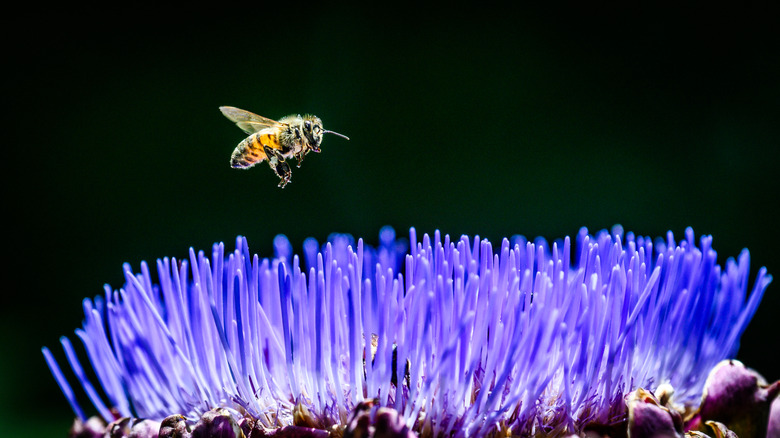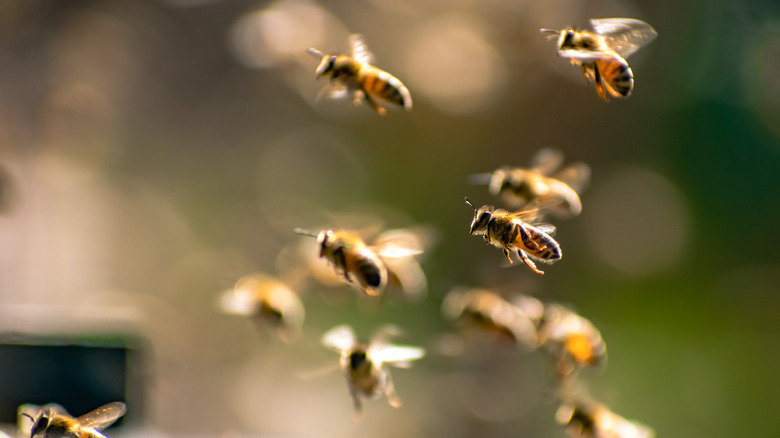How Slow-Motion Cameras Solved The Most Annoying Myth About Bumblebees
For decades, people have repeated a peculiar claim: that honeybees (and especially bumblebees) shouldn't be able to fly. According to conventional aerodynamic models, their chunky bodies and relatively small wings just didn't add up. By the laws of physics, bee flight should be impossible, so the myth went, and it was pervasive enough to take hold in popular culture as a symbol of how nature can defy logic. However, while the sentiment is inspiring, the science behind it has never been entirely sound.
The origins of the honeybee flight myth are hazy, but the most enduring version involves an aerodynamics engineer casually calculating that a bee's weight-to-wing-area ratio made flight impossible. Though some accounts attribute the claim to scientists like Ludwig Prandtl or Jakob Ackeret, it likely stems from a misunderstood 1934 observation by the French zoologist Antoine Magnan, who applied fixed-wing flight equations to insect wings and concluded — incorrectly — that insect flight defied aerodynamic theory.
The assumption didn't hold up under scrutiny, as the wings of living, flying organisms tend to operate differently than how airplane wings work. Bees were flying just fine, but no one could technically explain how. That is until researchers equipped with high-speed cameras and insect-scale wind tunnels decided to take a closer look. By filming bees in flight at thousands of frames per second, scientists were finally able to decode their wing movements in detail. The result wasn't just a solution to a longstanding scientific puzzle, it was a reminder of how much we still had to learn about creatures we have long studied. As it turns out, honeybee flight doesn't break the laws of physics, it just rewrites the rules we thought applied.
Discovering how bees actually fly
In 2005, a team of researchers at the California Institute of Technology finally cracked the mystery of bee flight using high-speed video and custom-built robotic wing models. By filming honeybees in flight at 6,000 frames per second, they were able to closely analyze the movement of the wings — and what they found was stranger than expected. "The honeybees have a rapid wing beat," study co-author Douglass Altshuler told LiveScience. "In contrast to the fruit fly that has one eightieth the body size and flaps its wings 200 times each second, the much larger honeybee flaps its wings 230 times every second."
This was counterintuitive because small insects tend to compensate for their lack of size with a higher wing-flap rate. For such a comparatively large bee to have a similar beat rate took the researchers by surprise. What makes the bee's wing motion so effective is its reliance on unsteady aerodynamics — a set of principles that apply when airflow changes quickly and unpredictably. Insects like bumblebees take advantage of these turbulent forces.
Specifically, their flapping creates a leading-edge vortex (a mini cyclone above the wing) that temporarily increases lift as each wing stroke reverses direction. Their wings also rotate between strokes, leading to additional lift, similar to how a spinning tennis ball curves through the air. It's a strategy that favors brute force over elegance: honeybees and bumblebees use a lot of energy to stay airborne. That's where the high-energy nectar they consume comes into play, giving them "power reserves" for biologically expensive aerodynamic maneuvers. This explanation doesn't just resolve the bee flight paradox; it puts their abilities in context with other flying insects and even hummingbirds. It has also inspired some engineers to apply these lessons to mechanical flight.
From bee flight to human engineering
The biomechanics of bee flight aren't just a fascinating biological curiosity — they've become a source of inspiration for engineers trying to rethink the future of aerial vehicles. After researchers deciphered how bees manipulate unsteady airflows to stay aloft with such small wings, roboticists began exploring how to mimic these mechanics in human tech. The Harvard-based RoboBee project was one of the most prominent in this area, leading to the creation of microbots no larger than a paperclip that can hover, dart, and perform complex maneuvers in the air by flapping tiny wings hundreds of times a second, just like bees do. And in 2025, the RoboBee received upgraded landing gear based on another insect — the crane fly.
While these micro air vehicles are still limited in flight time and energy efficiency, they hold promise for real-world applications. Considering the fact that bees are dying in record numbers, the question of what would happen if bees went extinct is, unfortunately, one humanity now has to contend with. Devices like the RoboBee could help aid large-scale pollination, assist search and rescue efforts, and improve environmental monitoring methodologies.
Researchers have even proposed the use of "entomopters," aircraft that fly in a manner similar to insects, to navigate low-gravity environments in space, surveying terrain on planets like Mars where conventional rovers might struggle. It seems that in the span of two decades, we've gone from solving the mystery of bee flight to using it as an inspiration for the future of human flight. And seeing that our understanding of other insects' flight abilities continues to grow — check out what butterfly wings look like under a microscope for a truly astonishing sight — the future of air travel could have its origin in bug biology instead of that of birds.


